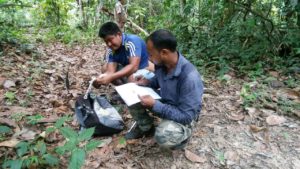The Transboundary Manas Conservation Area (TraMCA) of the Indo-Bhutan landscape, is a significant tiger habitat that has the potential to double its tiger population within a decade. The TraMCA with an area of over 6500 sq km spans from the river Sankosh, the western boundary of Ripu reserve forest in India to the Jomotsangkha wildlife sanctuary in Bhutan to the east.
The Bornadi-Jomotsankha forest complex on the eastern edge of the landscape offers an opportunity to replicate the Transboundary tiger conservation model already being implemented in the Manas-Royal Manas forest complex. This project has been collecting and analysing data for the past 1.5 years to create a baseline for long term research and conservation action in this as yet unexplored forest complex.
The project recorded 16152 camera images of 27 difference ground-dwelling mammals but recorded no tigers. The images highlighted threats from human activities including livestock grazing, fishing, hunting and non-timber forest product harvesting.
The results suggest that it would require considerable improvement of law enforcement along with community engagement to minimise human threats to ensure that numbers of prey animals are increased to eventually have a resident population of tigers.
The Bhutan government has strongly committed for conservation in the Jomotshankha WLS by expanding the area of the protected area by 925 sq km to the existing 335 sq km.
Aaranyak makes the recommendation that the Government of Assam similar actions to notify Khaling and Bhairabkunda Reserve Forests as Wildlife Sanctuary on the Indian side to ensure better law enforcement and protection of these forest complexes as one unit of forest.
The full outcomes and recommendations of the report can be read here.



